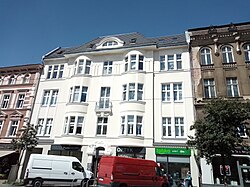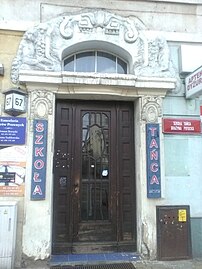Gdańsk Street 67, Bydgoszcz
The topic of this article may not meet Wikipedia's notability guideline for geographic features. (March 2015) |
| Tenement at 67 Gdańska street | |
|---|---|
Polish: Kamienica przy ul. Gdańskiej 67 w Bydgoszczy | |
 Tenement from Gdańska Street | |
 | |
| General information | |
| Type | Tenement |
| Architectural style | Modern architecture with Art Nouveau elements |
| Location | 67 Gdańska Street, Bydgoszcz, |
| Coordinates | 53°7′51″N 18°0′29″E / 53.13083°N 18.00806°E |
| Groundbreaking | 1910[1] |
| Completed | 1911 |
| Technical details | |
| Floor count | 5 |
| Design and construction | |
| Architect(s) | Rudolf Kern |
Tenement at Gdańska street 67 is a habitation house located at 67 Gdańska Street, in Bydgoszcz. It displays early forms of Modern architecture, with elements of Art Nouveau.
Location
[edit]The building stands on the western side of Gdańska Street, between Cieszkowskiego and Świętojańska streets.
It is also close to remarkable historical tenements in the same street:
- Józef Święcicki tenement at 63;
- Eduard Schulz Tenement at 66/68;
- Alfred Schleusener Tenement at 62.
History
[edit]The house was built in 1910-1911, on a design by the architect Rudolf Kern, who also erected or redesigned other buildings in Gdańska Street:[2]
Initial address was 40 Danziger Straße, first registered landlord in 1910 was Carl Ernst, a butcher[3]
In 1915, Hermann Boettcher purchased the building.[4] Boettcher was a successful entrepreneur of metalworking initially established in the 1890s in Chodkiewicza Street.
In 1932, at the location of a cafe, Kresowa, Klement Kwaśniewski opened a patisserie and bakery specialized in cakes. Other relatives had their office in the building:[5]
- Marta Kwaśniewska as a photographer;
- Ignacy Kwaśniewski as a businessman.
Today, a pharmacy occupies the ground floor premises[6] and a hotel is located in the backyard of the tenement.[7]
Architecture
[edit]The building presents characteristics of the first decade of the 20th century with early forms of Modern architecture and elements of Art Nouveau.
The facade is richly decorated with:
- a portal entrance, with children figure and vegetal forms;
- round bay windows
- peacocks balcony bas-relief;
- friezes surrounding openings;
- third floor windows are enhanced by high quality Art Nouveau vegetal motifs;
- a large eyelid dormer crowns the frontage.
The building has been renovated in 2020.
Gallery
[edit]-
Facade after renovation
-
Roof and adornements
-
Frieze beneath the roof
-
Main portal
See also
[edit]References
[edit]- ^ Gminna Ewidencja Zabytków Miasta Bydgosky. Bydgoszcz: Miasta Bydgoszczy. 24 April 2013. p. 80.
- ^ Jastrzębska-Puzowska, Iwona (2006). Od miasteczka do metropolii. Rozwój architektoniczny i urbanistyczny Bydgoszczy w latach 1850-1920. Bydgoszcz: Mado. ISBN 8389886715.
- ^ "names". Adressbuch nebst allgemeinem Geschäfts-Anzeiger von Bromberg und dessen Vororten für 1910 : auf Grund amtlicher und privater Unterlagen. Bromberg: Dittmann. 1910. p. 275.
- ^ "names". Adressbuch nebst allgemeinem Geschäfts-Anzeiger von Bromberg und dessen Vororten auf das Jahr 1915: auf Grund amtlicher und privater Unterlagen. Bromberg: Dittmann. 1915. p. 67.
- ^ Kziązka adresowa miasta Bydgoszczy. Bydgoszcz: Weber. 1923. pp. 163–164.
- ^ "Bydgoszcz, Gdańska 67". APTEKA DYŻURNA. APTEKA DYŻURNA. 2017. Retrieved 7 May 2017.
- ^ "Kużnia Hotel". Hotelkuznia.pl. Hotelkuznia.pl. 2017. Retrieved 7 May 2017.
External links
[edit]- (in Polish) Pharmacy at 67
- (in Polish) Hotel Kużnia
Bibliography
[edit]- (in Polish) Bręczewska-Kulesza Daria, Derkowska-Kostkowska Bogna, Wysocka A. (2003). Ulica Gdańska. Przewodnik historyczny. Bydgoszcz: Wojewódzki Ośrodek Kultury w Bydgoszczy. ISBN 9788386970100.





